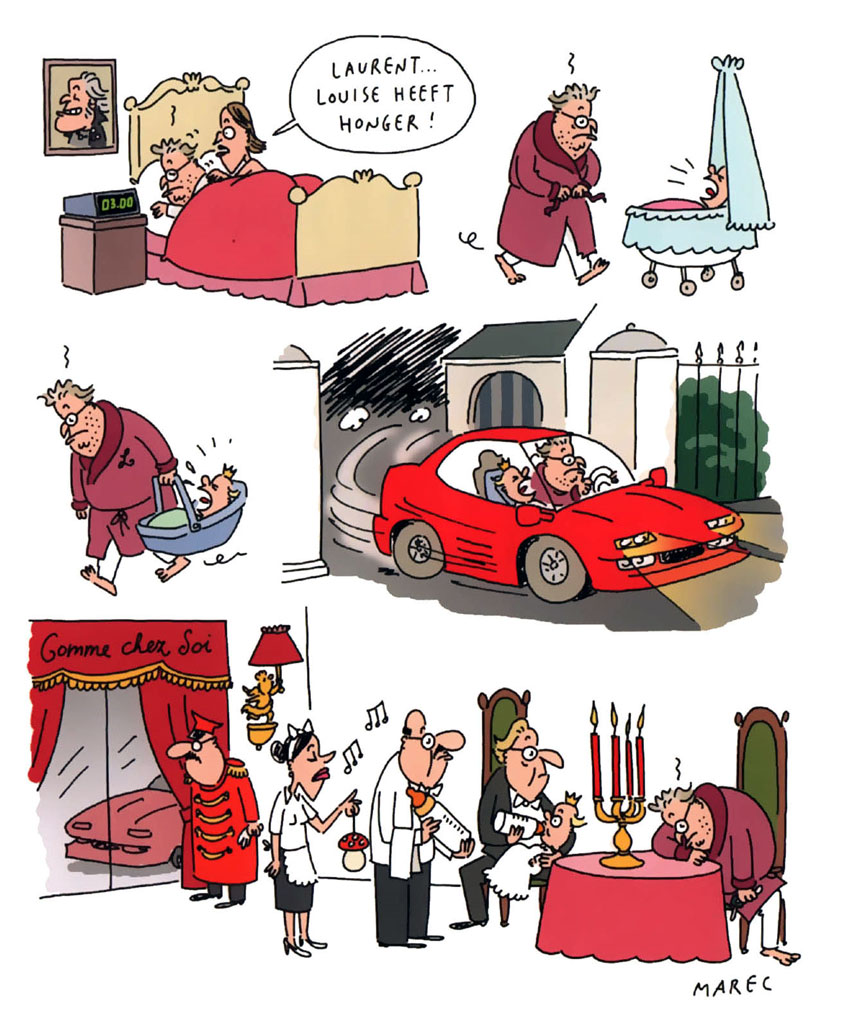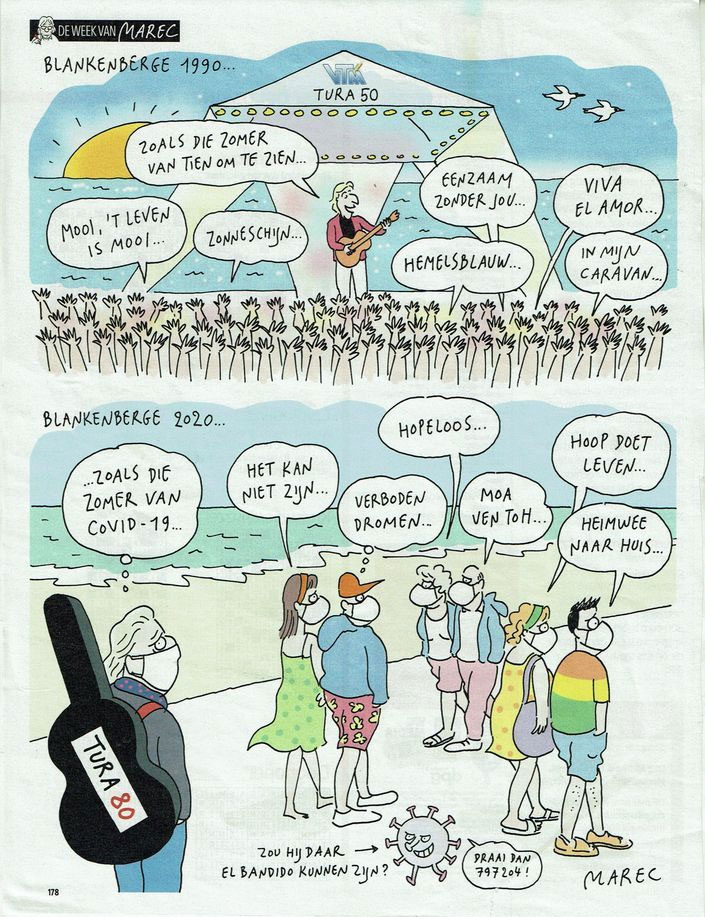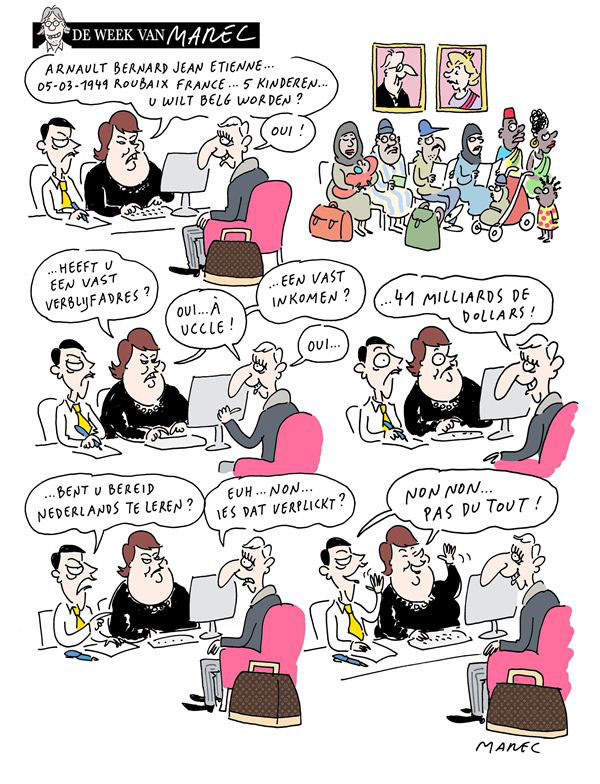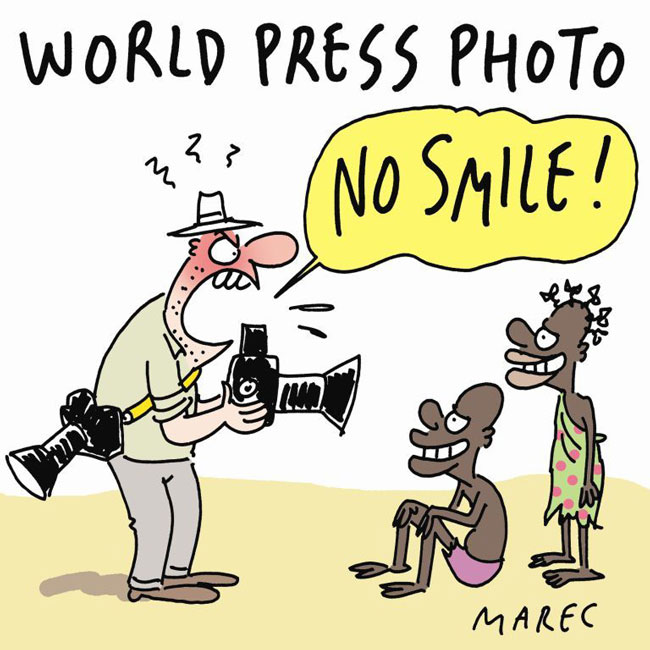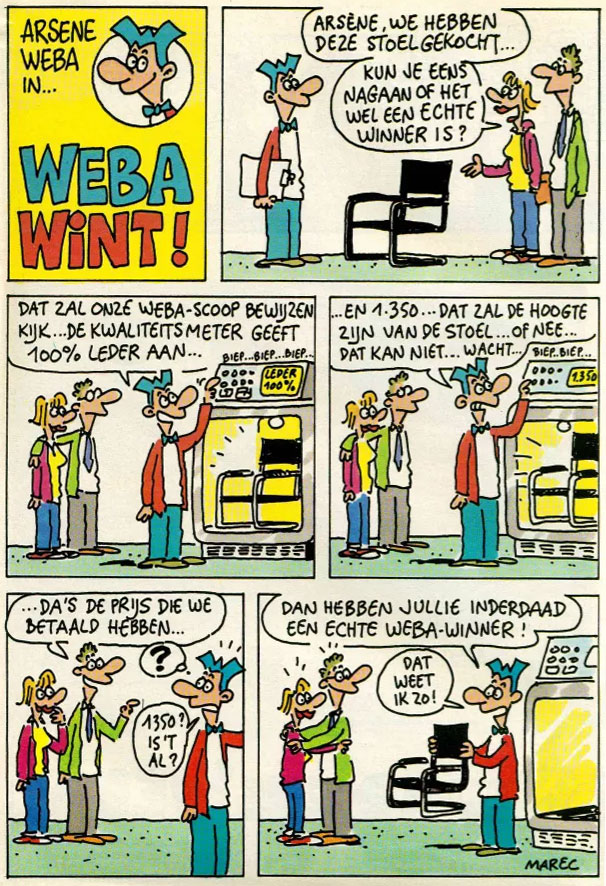Early 2000s cartoon by Marec, depicting Belgian Prime Minister Guy Verhofstadt solving the poverty crisis. Translation: "Box?" - "No, house!" - "Ah, yes, house!" - "No... box!".
Marec is a Belgian editorial cartoonist. Active since 1980, he mostly makes gags about current political and media events. He works in a loose, somewhat childlike style, which nevertheless manages to capture celebrities' faces in only a few well-chosen, striking lines. While many of his cartoons are one-panel drawings, he also uses the comic strip format. Between 1993 and 1999, his cartoons appeared in the newspaper Het Volk. Since 1993, he is house cartoonist for the TV weekly Dag Allemaal and since 1999 he has played the same role in Het Nieuwsblad and De Gentenaar. Together with thriller novelist Pieter Aspe, Marec has also made more serious graphic novels, based on real-life events. He was additionally notable as the founder of the online platform The Cartoonist, where Belgian press cartoonists can archive, contextualize, promote and sell their old and new cartoons.
Early life
Marec was born in 1956 in Bruges as Marc De Cloedt. His older cousin Guido De Cloedt was house cartoonist for the local newspaper Het Brugsch Handelsblad. As a child, Marec was a member of the Catholic youth movement KSA (Katholieke Studentenactie), where among his fellow members were future Flemish celebrities like journalist Pol Deltour, radio host Chris Dusauchoit and far-right politician Filip Dewinter. Marec said in interviews that it was odd in adulthood to portray his childhood friends in his cartoons, after they had become media celebrities. His earliest cartoons and comics appeared in the school paper of the Sint-Lodewijkscollege in Bruges. Later he studied at the Academy of Fine Arts of that city.
Marec grew up with all the classic Belgian comic artists. In the field of high art, he ranks Félicien Rops, James Ensor, Rik Wouters, Henri Matisse and Auguste Rodin among his favorites. His graphic influences in the world of editorial cartooning are Picha, Pirana, Brasser, Paul Jamin (Alidor), Royer and Gal (Gerard Alsteens). In the early 1970s, Marec met Kamagurka, who was by then already publishing cartoons, but not yet nationally famous. He introduced Marec to the subversive magazine Hara-Kiri/Charlie Hebdo, of which he particularly holds Georges Wolinski, Jean-Marc Reiser, Cabu, Charb, Tignous and Philippe Honoré in high esteem. Wolinski' simple, water colored drawings strongly influenced Marec's own graphic style.
Early career
In 1980, Marec published his first cartoons in the magazine Pourquoi Pas?. After illustrating large scrolls on the wall of the Bruges jazz café De Versteende Nacht, he was hired as cartoonist by the editors of the local entertainment monthly Uitkrant. He published in its pages until 1984. Other cartoons by his hand appeared in Wordt Vervolgd - the Dutch-language version of À Suivre - as well as the exclusive Bruges edition of the regional newspaper Het Nieuwsblad. Marec's drawings also had a weekly spot at the end of each episode of the TV debate shows 'Zeker Weten' (1989-1993) and 'Schermen' (1994-1996) on the Flemish public TV channel Eén (nowadays TV1), both hosted by Jan Van Rompaey.
Sequential cartoon from the 2004 collection 'Père Albert', depicting Belgian prince Laurent taking care of his new-born daughter, Princess Louise. In the first panel is his wife, Princess Claire, and in a framed picture, Père Gilbert, the "rock 'n' roll priest" who conducted their wedding ceremony.
Het Volk, Het Nieuwsblad and De Gentenaar.
In 1992, Marec's cartoons were introduced in the left-wing weekly Markant, which also employed the opinionated and controversial journalist Johan Anthierens. A year later, Anthierens' brother Karel became chief editor of the newspaper Het Volk. Since he followed his brother's work in Markant, he noticed Marec's cartoons. On 15 February 1993, he hired him as the new house cartoonist of Het Volk. It was a bold choice, because Het Volk was a Catholic paper. Many people in the editorial board were therefore somewhat suspicious about Marec's political leanings. They assumed he was Johan Anthierens' hand puppet. Each time Marec made a joke about the Church, the Pope or the Christian-democratic party CVP (nowadays CD&V), some of the editors were bound to feel offended. However, Karel Anthierens protected and defended him, but in 1994 he left the paper and was succeeded by a new chief editor, Jaki Louage. Two other long-time cartoonists in Het Volk, Pirana and hugOKÉ, were promptly fired. Marec feared he would be next, but Loauge actually wanted to keep him and ensured him more creative freedom. In 1994, Het Volk was sold to the VUM publishing group, owner of the newspapers De Standaard and Het Nieuwsblad. In 1999, Louage left Het Volk to join Het Nieuwsblad. Marec followed his editor and became the house cartoonist of Het Nieuwsblad and its sister paper De Gentenaar with his section 'De Week van Marec'.
'De Week van Marec' (Dag Allemaal #31, 2020). The first panel portrays Flemish singer Will Tura, performing in the coastal town of Blankenberge during the summer of 1990, broadcast on the TV concert show 'Tien Om Te Zien'. At the time, he celebrated his 50th anniversary. In the second panel this is contrasted with the miserable summer of 2020, when the COVID-19 pandemic made such mass events impossible. Tura also celebrated his 80th birthday then. The cartoon also references various song titles by Tura.
Dag Allemaal
In September 1993, Belgian Prime Minister Wilfried Martens announced his farm manure plan. Rather than discuss it in "serious" magazines, he gave an exclusive interview to the popular TV weekly Dag Allemaal in the hope of reaching a larger audience. On 14 September, Marec drew a cartoon about this media event, depicting Martens putting buckets of manure on top of the doors of his fellow government members, while saying: "Dag Allemaal" ("Hello Everybody", a pun on the title of the magazine he gave the interview to). Guido Van Liefferinge, chief editor of Dag Allemaal, noticed Marec's cartoon and asked him to work for his magazine. Since at the time Dag Allemaal was the best-selling magazine in Flanders, it was a tempting offer. Yet some of Marec's friends discouraged him to accept it for the very same reason. When he asked Johan Anthierens for advice, the otherwise snobbish author surprisingly enough told him to do it, "because, after all, even Wolinski draws for Paris-Match." Marec taunted Van Liefferinge a bit by asking for an excessive wage. Van Liefferinge halved it, but still employed the cartoonist. Much to Marec's surprise, he received his original asking price a year later. Van Liefferinge explained that he first wanted to test whether the cartoonist really wanted to work for him. His hunch was correct, because Marec has remained Dag Allemaal's house cartoonist since then.
2010 cartoon by Marec about the Belgian elections, when the political party N-VA became the biggest party in Flanders. Prime Minister Yves Leterme phones King Albert II to inform him: "Your Majesty, today we've woken up in a different country." However, the monarch interprets the information literally and says: "So what? Me too."
Style
Marec draws in a loose and fluid style, which has a certain child-like naïtivé and charm. This style was inspired by the fact that he had to reach daily deadlines and his drawings were printed in small corners of the papers' pages. Most of his work is inspired by current events, with a strong focus on media celebrities. Marec has the ability of capturing the facial features of politicians and media stars in just a few simple, recognizable lines. His cartoons often make use of puns, but are equally adept in visual comedy. Among the available book collections of his work are 'Echte Mannen Tekenen Ventjes' (1996), 'Op Papier De Beste' (2000), 'Collector's Item' (2001), 'Het Land van de Glimlach' (2002), 'Verse Lakens' (2003), 'Père Albert' (2004), 'Oh, Veilig België' (2005), 'Uitverkocht!' (2006), 'Seks en Drugs en Protocol' (2007), 'Leve de Crisis' (2009), 'De Marec-code' (2010), 'Kamer 2011' (2011), 'Cirque Sans Soleil' (2012), 'Kussen uit België' (2013), 'Leve Selfië' (2014) and 'Inkt, Zweet en Tranen' (2015). The latter book also contains a 16-page personal homage in comic strip form to the artists of Charlie-Hebdo magazine, who died in a terrorist attack on 7 January 2015. Later titles are 'Exit 2016' (2016), 'Marec 2017 Great Again' (2017), 'Real Fake News' (2018), 'Het Vaccin van Marec' (2020), 'Het Kompas van Marec' (2021) and 'De Invallen van Marec' (2022).
2012 cartoon by Marec, about French businessman Bernard Arnault, who considered naturalizing himself to a Belgian citizen, to escape tax laws in his home country. In the cartoon Arnault is interrogated by Antwerp mayor Bart De Wever and Minister of Health Maggie De Block, who ask him whether he has a permanent home, stable income and is willing to learn Dutch. When he informs them that he makes 41 billion dollars a year, it's suddenly no longer important whether he learns Dutch, or not.
Controversy
Like most cartoonists, Marec has also faced controversy. On 17 October 1999, he made a cartoon about the Médecins Sans Frontières (Doctors Without Borders) organization, which won the Nobel Prize for Peace that year. The drawing shows a group of starving Americans singing a birthday song to two doctors ("Lang zullen ze leven", translation: "Long shall they live"), which offended quite some readers. On 13 May 2000, he poked fun at the deadly explosion in the fireworks factory of the Dutch city Enschede by showing a group of disaster tourists looking in amazement at the spectacle, like they would do at a regular fireworks show. On 25 July of that same year, he ridiculed a plane crash with German tourists near Paris. His drawing shows a hotel owner complaining that "there aren't enough German tourists this year", while the plane plummets down into his roof. In both instances, readers felt this was disrespectful to the victims.
More outrage followed on 26 January 2001, when Marec drew Pope John Paul II battling Parkinson's disease by using his crucifix as a crutch. Readers felt this was offensive to people with Parkinson's disease. On 12 October 2009, the Belgian cyclist Frank Vandenbroucke died at age 34 from a pulmonary embolism in Senegal. Marec drew a touching tribute showing Vandenbroucke's bike, parked to a lonely tree in the Senegalese desert. He received no angry letters, but that evening he saw his cartoon being discussed on RTBF 2 television in the talk show Studio 1. Presenter Stéphane Pauwels misinterpreted the drawing as being humorous and expressed his disgust. In his book 'De Keuze van Marec' (2019), Marec recalled that he was once approached at the Antwerp Book Fair by a former employee of CDH party leader Joëlle Milquet. The man wanted to give her a signed copy of Marec's cartoons, because she apparently hated his work.
'Dossier van de Duivel' (2019).
Collaboration with Pieter Aspe
Marec was a good friend of famous thriller novelist Pieter Aspe. The cartoonist had the desire to make a serious graphic novel about the theme "the artist and his muse" and felt Aspe and his beloved wife Bernadette would be a good subject. However, on 31 August 2016, she died from lung cancer, and Marec abandoned his plans. When he talked with Aspe, he learned that he wanted to write a tribute to her. He told the widower about his original plan and Aspe felt it was a good idea. It nevertheless took a while before they found the right tone. Twice in a row, they had to start all over again. Their eventual book, 'Bea, Afscheid Van Een Muze' (September 2017), looks back on Aspe and Bernadette's 13-year relationship: how they first met, fell in love and how her early death ended everything. The written segments are told from Aspe's viewpoint, while the illustrated pages tell Bernadette's side of the story.
A year later, on 3 April 2018, Aspe and Marec founded the publishing imprint Aspe N.V. for their future productions. The company is located in their book store annex coffee bar De Loge in the Sint-Jakobsstraat in Bruges. On 2 December 2019, they published a new graphic novel, 'Dossier van de Duivel', a story inspired by a real-life anecdote. In the summer of 1890, a nude woman was arrested in Bruges. She showed signs of mental illness and was later identified as the well known courtisane Berthe de Courrière. De Courrière claimed she had fled from the home of a local priest who conducted some "strange actions". Aspe took this mysterious tale and wove a thrilling web of intrigues around it, set in late 19th-century Bruges. In his version, Berthe was a participant in satanic masses who fled after being raped by one of the other participants. She contemplates revenge, while the culprit is later murdered. Marec illustrated everything in a style similar to 19th-century artist Félicien Rops. Real-life historical characters like De Courrière, as well as priest Ludovicus van Haecke, writers Remy de Gourmont, Joris-Karl Huysmans and Guido Gezelle appear as characters. Marec also gave his own great-grandmother Marie-Thérèse Vonck, AKA Mietje Vonck (1869-1949), a cameo. To promote their book, Aspe and Marec hired the Ryelandt room, which was once a church but is nowadays used as a concert hall, and organized a mock-satanic mass there, inviting striptease artist Fay Loren to perform.
Cartoon about the World Press Photo contest (9 February 2008).
Erotic art
In 2014, Marec published '100 Erotische Tekeningen', a book with erotic drawings. The forewords were written by cartoonist Herr Seele and Dutch music producer Hans Kusters.
Animation career
Marec made animated intermezzos for the human interest program 'Het Hart van Vlaanderen' (1999-2002) on the Flemish commercial TV station VTM. They functioned as humorous introductions and bumpers between each item. Some of Marec's later cartoons have been animated by Studio Volstok, where his son Thijs De Cloedt is co-director and producer.
'Arsène Weba' advertising strip.
Advertising career
In 1986, Marec made a series of advertising comics to promote furniture company Weba in Ghent and Deinze. He invented a comic character with blue hair in the shape of the letter "w", named Arsène Weba. Over the decades, the comics appeared in Weba's advertising folders and the newspaper De Streekkrant. Between 1990 and 2016, the character also appeared in animated TV spots, produced by Studio Bal Gehakt. The cartoons featured supporting characters like a mustached slob, his attractive wife and their son, who are always motivated by Arséne to visit his store. For additional comedy, all the characters talk in East-Flemish dialect.
The Cartoonist
In 2014, Marec founded the collective "The Cartoonist", which unites Belgian press cartoonists and organizes exhibitions and events to promote the press cartoon. On its website, Belgian cartoonists can make their archived and new work available to the public. The site provides information about future exhibitions, book publications and offers the ability to buy original artwork. 26 cartoonists have joined his initiative, including Clou, Cost, Cécile Bertrand, Johan De Moor, Frédéric duBus, Kim Duchateau, Fred, Gal (Gerard Alsteens), Ilah, Joris Naet, Kamagurka, Kanar, Karl Meersman, Pierre Kroll, Lectrr, Steve Michiels, Quirit, Jacques Sondron, Nicolas Vadot, Fritz Van den Heuvel and Zaza.
'David & Co Bij... Meester Kaaiman Op Ontdekkingsreis Naar Het Middelbaar Onderwijs' (1992).
Graphic contributions
In the late 1980s, Marec illustrated a campaign for Greenpeace to direct attention to the hole in the ozone layer. In 1988, he designed the cover of two musical singles, 'Geef 'n Pint' and 'M'n Velo' (1989) by the comedy band De Brugse Strangers, who sing in West-Flemish dialect. In 1992, he made the educational comic book 'David & Co Bij... Meester Kaaiman Op Ontdekkingsreis Naar Het Middelbaar Onderwijs' (1992) in co-production with the Communal Ministry of Education and the Educational Service KAV-KWB. The story aims at pupils who prepare for high school. Apart from a book release, it also appeared as a supplement in the children's magazine Zonneland.
He was one of many cartoonists to pay homage to the cartoonist Gal (Gerard Alsteens) in his book 'De Overspannen Jaren' (Epo, 1996). Marec has illustrated Goedele Liekens' sex manuals 'Ons Vaginaboek' (Standaard Uitgeverij, 2004) and 'Ons Penisboek' (Standaard Uitgeverij, 2004). He also joined his fellow countrymen in offering special cartoons for the book "België, Et Cetera" (Van Halewyck, 2016) by Gilles Dal, a funny look at the history of Belgium in numerous thematically fitting cartoons and comics. Marec designed a stamp for the Belgian post company about the theme "Humor makes power."
Marec is additionally a member of Cartooning for Peace. His work has been admired by fellow cartoonists Gal (Gerard Alsteens), Karl Meersman, Jef Nys and Pirana. Other notable celebrity fans have been music producer Hans Kusters, sexologist/TV host Goedele Liekens, Prime Minister Jean-Luc Dehaene and Belgian prince Laurent.
Recognition
In 1999, Marec won the first Press Cartoon Belgium contest, organized by Karel Anthierens. One of the jury members that year was the French cartoonist Georges Wolinski, who personally picked out one of Marec's cartoons as his favorite. Marec won the contest again in 2015 with a cartoon depicting terrorist Fouad Belkacem at his trial. The drawing shows a resemblance between a lawyer in black, and the black-bearded terrorist in white. Much to Marec's amazement, Belkacem's lawyer gave him a phone call and told him his client loved the cartoon. He even wondered whether he could buy it. Marec was intrigued that a religious fundamentalist would find this particular cartoon funny and asked whether he could talk to him first. Yet since Belkacem was in custody he was only allowed visits from family members. During the 2001, 2004, 2008, 2018 and 2019 editions of the Press Cartoon Belgium Contest, Marec won second prize. In 2012, the crowned cartoonist won a Special Achievement Award. In 2023, Marec received a Lifetime Achievement Award at the cartoon festival in Knokke-Heist
In 2013, an exhibition of comics and cartoons was organized in the Flemish parliament by art curator Jan Hoet and politician Dany Vandenbossche. One of the members of the Flemish-nationalist party N-VA, Jan Peumans, felt the need to have a French-language speech balloon by François Schuiten on the poster changed into Dutch. This sparked protests from several cartoonists who participated, including Marec.
Books about Marec
Marec was interviewed in Roel Daenen's book 'Het Is Maar Om Te Lachen: Hoe Cartoonisten De Wereld Veranderen' (Polis, 2016), which collects interviews with Belgian cartoonists regarding censorship, in the light of the 2015 terrorist attacks at Charlie-Hebdo's headquarters. An overview of Marec's cartoons and career appears in the book 'De Keuze van Marec' (Van Halewyck, 2019).
Cover drawing with self-portrait for the career-spanning book collection 'De Keuze van Marec' (2019). From left to right (first row): tennis champion Kim Clijsters, pop musicians Prince, the Twitter bird logo and Michael Jackson. In the second row is Belgian Prime Minister Jean-Luc Dehaene, German chancellor Angela Merkel, U.S. President Bill Clinton and pop musicians David Bowie and Amy Winehouse. The third row features Belgian king Albert II, Russian president Vladimir Putin, terrorist Osama bin Laden, French president Nicolas Sarkozy, U.S. President Barack Obama and Swedish activist Greta Thunberg. The final row portrays Belgian queen Fabiola, Pope John Paul II and U.S. President Donald Trump.




